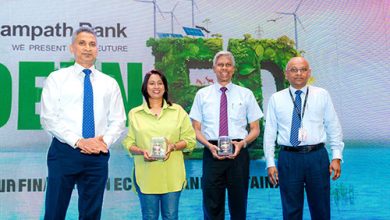BANK OF CEYLON
“Bank of Ceylon Paves the Way for Drone Technology in Sri Lankan Agriculture”
– Interview with Prof. Buddhi Marambe
Drones have revolutionised industries worldwide, from defense to logistics, and now, in Sri Lanka, they are making a transformative impact in agriculture. With the support of the Bank of Ceylon (BOC), drone technology is being introduced to optimize agricultural operations, improve efficiency, and support sustainability efforts.
Professor Buddhi Marambe, an expert in climate-smart agriculture and food systems, has been at the forefront of these efforts. With over 38 years of experience in academia and research at the University of Peradeniya, he has contributed significantly to climate change adaptation strategies and innovative agricultural practices in Sri Lanka.
In this interview, Professor Marambe shares insights on the evolution of drone technology in the country, highlighting the Bank of Ceylon’s critical role in funding training programs for drone pilots, enabling large-scale implementation, and supporting research into agricultural and environmental applications. From precision farming to conservation efforts, drones are proving to be a game-changer, and with BOC’s support, Sri Lanka is witnessing a shift toward technology-driven, sustainable agriculture.
Following are the excerpts of the interview.
May I know how drone technology was introduced and developed in Sri Lanka? Also, what role did the Bank of Ceylon play in supporting its early plans and growth?
Drone technology has been in use around the world for a long time, especially in developed countries, where it has been used as an effective way to ensure precise application of inputs in agriculture and other areas. It helps reduce the use of fertilizers, saves water, and cuts down the time needed for different tasks. In agriculture, drones are also used for monitoring.
There are two main types of drones used in agriculture: those for surveillance and those for applying inputs. As for Sri Lanka, it is difficult to say exactly who introduced drone technology. However, in 2014, there was an attempt to start a drone service operator in the country. This initiative was launched as a subsidiary of a leading private company aiming to provide drone-based services. But it lasted only a year, as people were not ready to adopt the technology. There was little understanding of its benefits and drawbacks, and only a few private-sector organizations were willing to invest in it. As a result, commercial operations did not continue at that time.
The idea was brought back in 2020s, and this time, it moved forward with support from the Skills Development Council, Kotelawala Defence University, and the private company Kenilworth International. They decided to train drone operators, as handling drones requires skill. Unlike simple remote-controlled vehicles, drones need careful and accurate control, and not everyone can operate them properly.
A major step forward came when the Ministry of Agriculture and Kenilworth International worked together in a public-private effort. Kenilworth International was able to secure an investment—reported to be around 1 billion, through financial assistance from the Bank of Ceylon. The involvement of BOC in helping bring new technology into agriculture was important, as it allowed farmers and other stakeholders to use drones to improve efficiency in applying inputs.
It is also worth mentioning that the technology to build drones is widely available, and many small companies in Sri Lanka have started making their own drones for different uses. However, the key factor is the software that operates them. This is why the partnership between the Bank of Ceylon and Kenilworth International was useful; they invested in one of the most advanced drone operating systems available today.
The drones used belong to the DJI T-series, a well-known brand recognized worldwide for its accuracy and reliability. These drones are designed specifically for agricultural work, ensuring that inputs are applied correctly and efficiently. The Bank of Ceylon’s support for this project has allowed new technology to be introduced into agriculture, helping improve the way work is carried out in the sector.
What is your view on how drones, with the support of the Bank of Ceylon, have contributed to improving efficiency and productivity in paddy, tea, rubber cultivation, and other plantation industries?
Right now, drones are being used on a larger scale, particularly in the paddy sector, though they are also gaining traction in tea plantations.
Let me take paddy cultivation as an example. Currently, there are about 565 agrarian service centers in the country. Of these, 64 have been selected to introduce drone services, where trained operators from various institutes have been deployed to apply agricultural inputs in farmers’ fields. This is a great step forward—a long-awaited practical implementation of modern technology. Credit goes to the Bank of Ceylon for providing financial support and placing trust in the private sector entity involved, as well as in the technology itself, with a vision to improve agriculture in the country.
At present, these 64 agrarian service centers each have a trained drone pilot stationed there with the support of the Ministry of Agriculture. Through an agreement with the Ministry, a paid drone service is now available to farmers, particularly in paddy cultivation. Whenever farmers request assistance in applying inputs, whether spraying or other applications, the service is provided using this technology.
Here’s how it works: drone technology allows farmers to apply inputs with precision, ensuring an even and accurate aerial distribution. This is especially useful for agrochemicals such as pesticides, herbicides, and fertilizers. One of the biggest concerns in agriculture has been the indiscriminate use of these chemicals. Whether or not all criticisms of farmers on
This issue is justified, there is no doubt that drones can address this problem by ensuring optimal and measured application.
Another key benefit is the time saved. Traditionally, applying pesticides to an acre or a hectare of land takes a significant amount of time. As the land area increases, so does the time required. With drone technology, however, aerial spraying can be done quickly and efficiently, allowing farmers to complete operations in a much shorter time while maintaining accuracy.
Drones have the potential to apply herbicides and pesticides only in selected areas where problems are detected. Using remote sensing or satellite data, drones can identify infestations and apply chemicals only where needed. This would be a major environmental benefit, as it minimizes unnecessary chemical use. However, additional training is required for drone pilots before this function can be fully implemented in agricultural operations.
Another important advantage relates to water conservation, which is particularly relevant given the country’s limited fresh water resources. Traditionally, when a farmer applies pesticides using a 16-liter knapsack sprayer, the recommended application rate is ten tanks per acre, totaling 160 liters of water per acre. In contrast, drones require only 20 liters of water to apply the same amount of pesticide over the same area. This results in a water saving of 140 liters per acre, a significant reduction in water usage.
Currently, tests are being conducted at Mahailluppallama, at the Field Research and Development Institute, and at the Rice Research and Development Institute in Bathalagoda. These trials aim to determine the best and most precise methods for applying granular fertilizers and for broadcasting seed paddy using drones. Instead of relying on manual labor for seed broadcasting, aerial application is now being tested.
These advantages highlight the potential of drone technology in agriculture. The Bank of Ceylon has played a key role in supporting this initiative, which is undoubtedly shaping the future of the sector.
In your collaboration with the Bank of Ceylon, how has their support contributed to the advancement of drone technology, particularly in terms of pilot training and industry applications?
Flying a drone is not as simple as flying a kite. While anyone can technically lift a drone, proper operation requires skill. There are trained drone pilots responsible for launching drones, and my role has been to train them on how to use drones for agricultural applications.
The investment provided by the bank helped fund these training programs. Without properly trained drone pilots, it would not have been possible to implement this initiative effectively in the field. This is a key reason why the Bank of Ceylon’s involvement has been so important, it has supported the development of skilled professionals, ensuring that drone technology is applied in agriculture with precision and efficiency.
In what ways have drones been used for surveying, security operations, and naval-based activities, and what impact have they had?
Drones have been used for security operations and surveillance, though I am not an expert in that area. However, I do know that they play a valuable role in supervision, particularly in large-scale agricultural operations such as tea plantations. As I mentioned earlier, plantation managers gain a significant advantage by using drones for monitoring activities in these vast areas.
Drones can also be used for agricultural land assessments, identifying problem areas such as nutrient deficiencies, pest infestations, weed growth, and diseases. This kind of surveillance helps with follow-up actions, ensuring that issues are addressed quickly before they spread across larger areas.
Another important benefit of drone surveillance is labor management. In tea plantations, for example, drones can help monitor whether plucking is being done in the right fields, at the correct time, and at the proper intervals. Some plantations also use drones to track labor movement, ensuring that workers are where they need to be and that work is being carried out efficiently.
These are just a few examples of how drones are being used for monitoring and security purposes, demonstrating their potential to improve oversight and efficiency in large-scale agricultural and security operations.
Drones have mostly been used for warfare around the world. However, in Sri Lanka, there seems to be a shift toward using them for humanitarian purposes. What is your opinion on this changing trend, Professor?
Yes, drones can be highly effective, provided they are used responsibly by knowledgeable professionals. This is why, at present, there is no plan to sell drones directly to individuals. Instead, trained professionals and skilled operators are using them to assist farmers and other stakeholders through a service-based approach. This ensures that drone technology is applied efficiently and safely without the risks associated with unregulated usage.
I don’t think a country like Sri Lanka can allow unrestricted ownership and use of drones, as they could be misused for various activities. However, you raise an important point about their role in humanitarian efforts. This is an area that should be further developed, especially in situations where drones can help locate people in distress during natural disasters.
Drones can play a crucial role in rescue operations, particularly when the armed forces and emergency responders need to evacuate people from dangerous situations. Their ability to conduct aerial surveillance and provide real-time data makes them invaluable tools for disaster response and humanitarian aid. This is an aspect of drone technology that should continue to expand, ensuring that it serves the people in times of need.
How effective have drones been in addressing the human-elephant conflict and monitoring elephant populations? What challenges have been encountered?
There have been several efforts to use drones to warn people, particularly in rural areas, about the migration pathways of wild animals—especially elephants. The goal has been to raise awareness and alert communities about potential danger. However, one of the major challenges we have encountered is that when small drones are flown near elephants, the animals often lose their orientation. In many cases, this has led to unintended consequences, making it clear that further research is needed.
There are two key aspects to consider. First, drones should effectively communicate real time information to people in vulnerable areas about the movement of wild animals. Second, we need to determine whether the drones themselves may be disturbing the animals due to the noise they produce. Elephants are highly sensitive to low-frequency sounds, and drone operations could potentially distress them.
This is an area that requires further study. If drones are to be used as an early warning system and as a tool to guide animals away from human settlements, they must be deployed in a way that does not disorient or agitate the animals. Otherwise, the unintended consequences could outweigh the benefits. Future research should focus on refining drone technology to ensure it can be used effectively without negatively impacting wildlife.
How has the Bank of Ceylon supported drone-related projects and the development of drone pilots? What impact has this had on the economy?
To assess the long-term impact, we need more time, as drones have only been used on a relatively large scale for one season so far. However, there is already a clear need for more skilled drone pilots to expand operations into other areas of Sri Lanka. The current financing mechanism for training and deployment is managed by Kenilworth International, and I am sure more partners will come on board in the future to help expand these efforts.
I would also like to acknowledge the role of Kenilworth International, partnership with BOC in supporting universities. They have contributed significantly to the Faculty of Agriculture at the University of Peradeniya, not necessarily in training drone pilots but in broader drone
operations. This investment has been valuable, despite some initial challenges in getting people on board with the technology. Over time, it has proven to be a successful initiative that adds value to the overall agricultural ecosystem and supports sustainable development in the country.
As I mentioned earlier, drones offer multiple benefits in agricultural operations. They save money, reduce the time required for input application, and ensure precision in their use. From a climate change perspective, they also contribute to water conservation, which is crucial in a country like Sri Lanka. These advantages highlight the importance of scaling up drone operations across all agro ecological regions in the country.
The Bank of Ceylon can take pride in having played a key role in initiating this activity in partnership with investors. Their financial support has helped introduce a technology that not only enhances efficiency in agriculture but also contributes to long-term sustainability.






